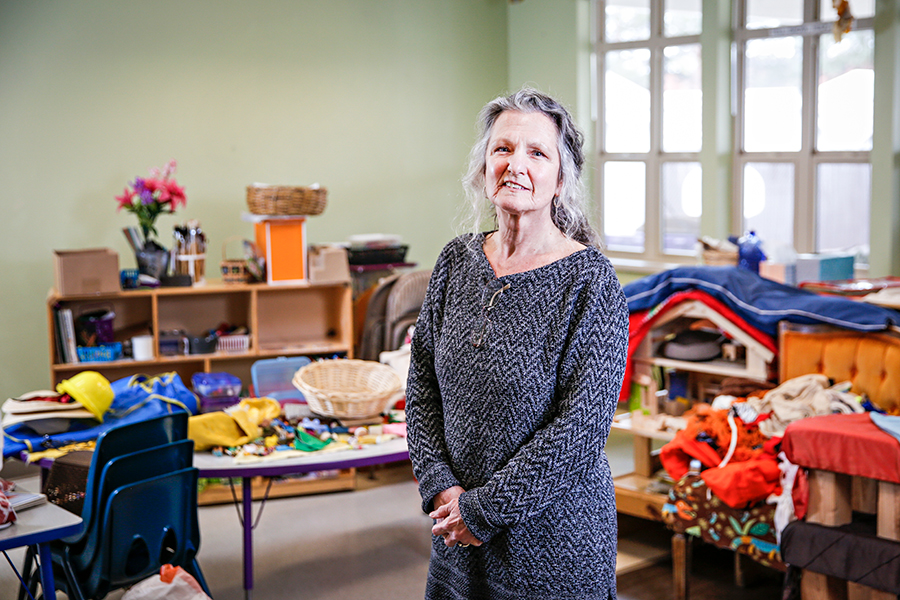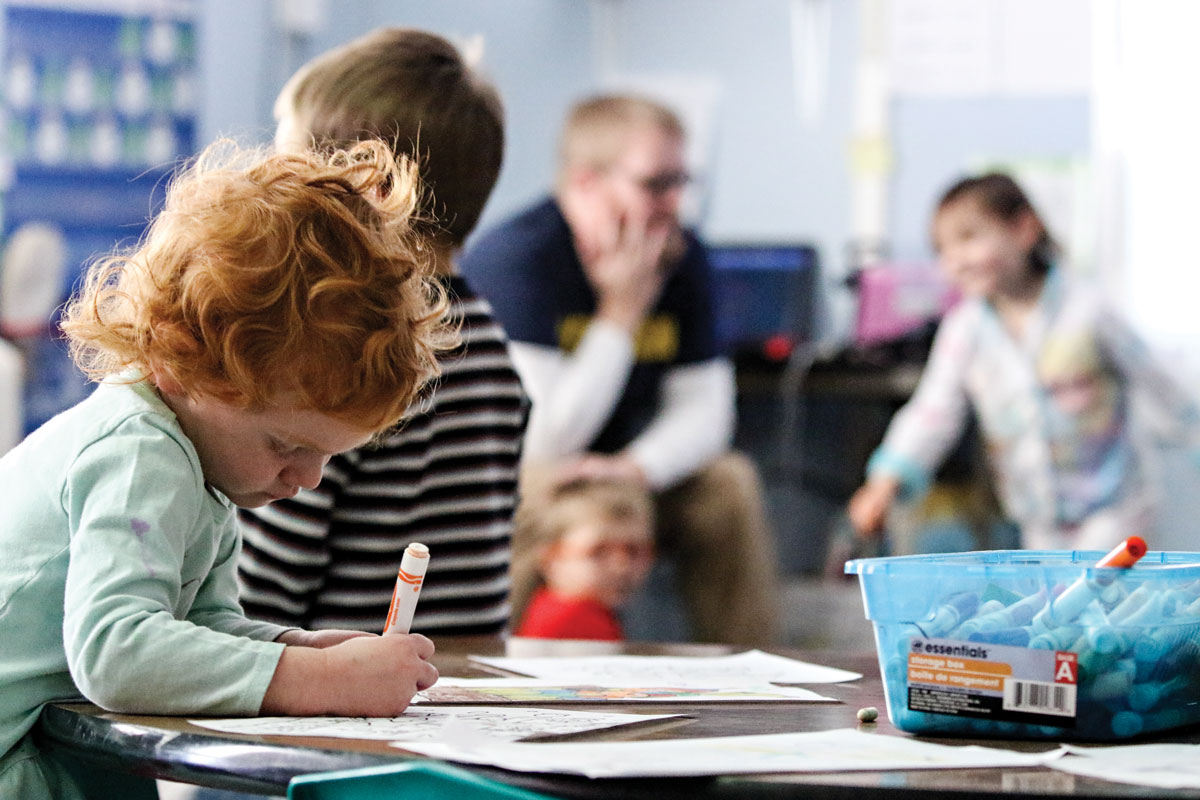Two realities in Montana, distinct yet intertwined, spell difficulty for recruiting and retaining the next generation of workers and families: lack of affordable housing and childcare. All of which raises questions about the direction and sustainability of the valley’s growth, as well as the demographic makeup of an area that already trends older.
Soaring home and rental prices that are fundamentally incompatible with average local wages, along with a housing shortage, create a heavy counterweight to other features that would otherwise draw young families, to either move or stay, such as outdoor amenities and a slower pace of life.
Meanwhile, even if they can afford to live here and are able to find a house, the state’s existing childcare meets less than half of demand, and only the lowest earners qualify for government support, leaving the majority of working and middle class residents on their own to pay for expensive, unsubsidized childcare, or to stay out of the workforce.
“You put a lot of time and energy and effort into bringing good-quality workers into the valley,” Jerry Meerkatz, the president and CEO of Montana West Economic Development, said at the Kalispell Chamber of Commerce’s May 18 Growth Summit.
“But with the phenomenal time that we’re in, some of those workers say, ‘I’d love to come, but I can’t bring my family. I can’t live here.’ Whether it’s about housing or overall cost of living, which includes childcare … it’s a scary time.”
Collette Box, a longtime early childhood advocate who has been director of Kalispell’s Discovery Development Center since 1995, believes there’s one obvious but as-of-yet unattainable remedy for the childcare problem: more public funding.
Box and others in her field say the first step is to further shift an ingrained cultural ethos, laden with remnants of the nuclear family era when women were expected to care for kids at home rather than join the workforce and children weren’t considered broader social responsibilities until reaching grade school.
“The biggest challenge is always just getting people to understand the importance of the early childhood years,” Box said. “I have a mantra: children were born before the age of 5.”
In a July 2020 report, the Montana Budget and Policy Center called childcare an “essential part of our economy” that has suffered from “decades of underinvestment,” adding that the state’s industry is “at a crossroads.”
Early childhood advocates hoped the pandemic might change that calculus by shining a light on the relationship between childcare and the economy. The thinking was that if childcare were more widely understood as an economic concern, and promoted by the business community, policymakers would work to deliver solutions.
When former Gov. Steve Bullock deemed childcare an essential service at the height of the pandemic, it hinted at a breakthrough.
“I had been waiting 30 years to hear that,” Box said.
But while the federal government has shown an appetite for increasing support for families and childcare providers, most clearly distilled in the Biden administration’s proposed American Families Plan, little came out of this year’s state Legislature to suggest a wholesale shift in approach, although the unaffordability and limited availability of childcare was a much-discussed topic.
Bullock, a Democrat, made state-funded preschool a top priority but was never able to get it past the point of a pilot program, which was shown to boost kindergarten readiness among participants by 21%, a metric that impacts later school performance and graduation rates, according to a large body of research. He included $10 million over two years for preschool in his budget proposal before leaving office, but his successor, Republican Greg Gianforte, nixed it in his own proposal.

Montana remains one of the few states in the U.S. without state-funded preschool, nor does it supplement federal funding for the low-income Best Beginnings childcare scholarship program as other states do, according to Grace Decker, strategic collaboration coordinator for Zero to Five Missoula County, an early childhood advocacy group.
The Legislature did pass House Bill 624 with a bipartisan vote to establish a task force to explore potential ways to remedy the affordable childcare crunch, but Gianforte vetoed the bill, arguing that action was needed rather than more studies. Gianforte pointed to a pot of federal stimulus money set aside for childcare, although advocates note that the one-time funding isn’t a sustainable solution.
The Legislature also cut $2.4 million out of the budget for the STARS to Quality program, which offers incentives for childcare providers to offer higher-quality services.
“If we aren’t able to restore that funding, I think the impact will be far reaching,” Decker said. “It’s hard to overemphasize the importance of the STARS to Quality program.”
Quality is a central concern for both advocates and families. When parents are desperate to find childcare to get or keep a job, they may end up choosing whatever is available regardless of quality, potentially leading to unlicensed and perhaps unsafe providers.
Sadee Miller, who worked for six years at Flathead Valley Community College’s Early Childhood Center and now works at Little Dreamers Childcare in Evergreen, said in its mission to ensure quality, the STARS to Quality program offers money to purchase materials. Without such funding, Miller said providers and teachers are often forced to reach into their own pockets.
“And we can barely survive in the housing market and in the valley,” she said.
The other notable childcare-related bill that passed this year’s Legislature was opposed by industry leaders, who felt it potentially trades quality for minimal cost benefits, and does little to address the big-picture issues. That legislation, Senate Bill 142, increases child-to-teacher ratios, which Decker says “provides a tiny bit of more access and a tiny bit of reduced quality.”
“Public funding is what we need to be seeing and that bill doesn’t provide that,” Decker said. “It’s really moving in the wrong direction because it’s keeping the onus on the providers and the families and the children. We need to look at it as a community need and essential infrastructure that we invest in as a society. Most states do, in fact.”
“We would advocate for a more comprehensive solution,” she added.
While teacher-to-child ratios do contribute to the expense of childcare, advocates point out that providers, with access to scattered funding sources but no stable state support, are responsible for numerous overhead costs: materials, food, utilities, garbage, rent or mortgage, personnel and training, and multiple shifts covering 12-hour days that ensure childcare is open for families before and after business hours.
In short, a lot of costs are involved with caring for and educating kids who often spend more time at childcare than at home, and Decker says providers, families and staff can’t continue to solely bear the financial burden as cost of living skyrockets.
“Parents can’t shoulder the costs alone for something that is essential and continue to support their families,” she said. “And workers can’t really subsidize that any longer. We’ve had a situation for many, many years where childcare has been among the lowest-paid fields.”
Miller, of Little Dreamers, said childcare workers “don’t have a livable wage,” and Box of Discovery Developmental Center noted that she lost staff during the pandemic and hasn’t been able to refill all the vacancies, describing the difficulties of hiring college-educated teachers at low wages.

By making the finances pencil out, Decker said public funding would help alleviate the overall shortage.
“Montanans are good businesspeople, and if they saw that there was consumer demand for a product that was lucrative to produce, there would be more people stepping into that space and providing that needed service, but there aren’t,” she said.
Childcare providers across the state closed when the pandemic swept into Montana last March, and although many began operating again, often with curtailed services, a few shuttered for good and others have yet to reopen, further exacerbating the existing shortage. Providers across the board report long waiting lists.
One facility that closed last spring was FVCC’s Early Childhood Center. The innovative center opened in 2008 in a 7,140-square-foot facility with a dual mission to serve as both a learning laboratory for students in the early childhood field and a childcare provider for students, staff and the broader community.
In an interview last week, FVCC President Jane Karas said the college is working on a plan to reopen the facility, which could involve a bid process to partner with another entity in the industry.
“The idea would be for it to help meet childcare needs, especially for our students, and it has also served the community as well,” Karas said. “We do know childcare is an issue for many and hopefully we’ll be able to address that and the needs of the community as we move forward.”
When Zero to Five Montana released its data-driven “State of Babies” report last month, Executive Director Caitlin Jensen listed areas where the state could potentially boost its investments: “quality child care, safe and stable housing, home visiting services, family-friendly employer policies and tax credits that benefit families with young children.”
“The data tells us the time is now for policymakers, parents and community leaders to work together to forge new partnerships and strengthen our community and state infrastructure for children today, who will be our workforce in the not-so-distant future,” Jensen said.
New partnerships are in fact being forged. Grassroots collaborations seeking childcare solutions are underway from Missoula to West Yellowstone, featuring chambers of commerce, economic development groups, county governments and other stakeholders. Local economic leaders, including Meerkatz of MWED and the Kalispell Chamber of Commerce president, have also expressed interest in such efforts.
Despite the lack of tangible action, Decker said it’s “exciting” to see the increased interest in, and dialogue about, the issue of childcare among communities and policymakers.
“They’re having these conversations and talking about this as a challenge,” she said,” Decker said. “That doesn’t mean people quite know what to do. It’s one of those problems that’s probably going to take multiple different kinds of actions by multiple different kinds of stakeholders for there to be progress.”
